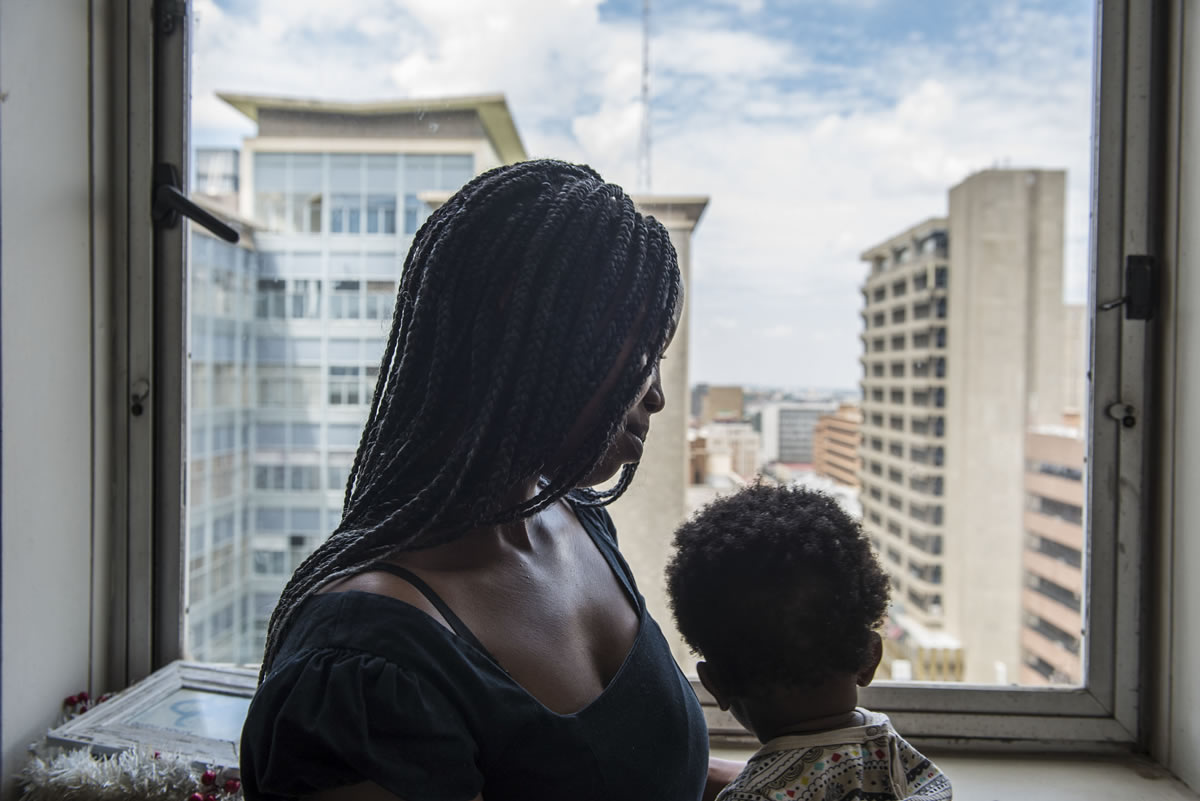Water births are a growing phenomenon in South Africa and globally. But this birth method is controversial – scientific evidence is lacking.
On a cold Monday morning in June, Anele Nzimande (23) prepared herself for what she considered one of the defining moments of her life. It was a moment she had been looking forward to for months.
Nzimande was nine months pregnant. That morning, she entered her 24th hour of labour. Her contractions had started at 9am on the Sunday and intensified overnight.
At 8am on the Monday morning, she frantically started to make her way to the birthing clinic where she would deliver her child.
“I was in pain and very irritable because I hadn’t had a good sleep. I’d close my eyes, ready to drift off only to be interrupted by another contraction,” she remembers. “I just wanted to have my baby.”
Nzimande went to the clinic armed with Bible verses, gospel music and a book about giving birth with as little pain as possible.
Her partner and a friend drove to the centre with her, where her midwife and doula (a birthing companion) were waiting for her.
The labour pains became unbearable as Nzimande started to dilate. She was pacing up and down her clinic room. At times, she squatted to relieve the discomfort.
But Nzimande still had a long way to go before she could meet her baby.
When she discovered she was pregnant, the young woman started to research the different ways she could deliver her baby. She didn’t want to give birth to her child in a hospital.
“I wanted tranquillity and to be surrounded by the people that I love. But most importantly I wanted privacy and a cosy environment that would allow me to record the birth,” she explains.
Nzimande eventually opted for a water birth, where her labour and the delivery of the baby happens in a bathtub instead of on a dry surface such as a bed. “I hated the idea of having a baby with a gynaecologist next to me,” she argues. “That, along with a hospital, with its rigidity, was not appealing to me. I wanted to do things differently and experiment.”
Facilities few and far between
Water births became available in the United Kingdom in the 1980s, according to research studies. At the time, this method of delivery became popular because of the increase in midwifery-led care for expecting mothers, a 1993 study in Journal of Midwifery & Women’s Health reports.
Jeanell du Plessis, a midwife and unit manager at Genesis Maternity Clinic in Johannesburg, says she’s seen an increase in water births in South Africa over the past decade at the clinics where she has worked. “But we don’t have enough facilities that offer them. Some private hospitals in Johannesburg have water baths but they are not necessarily used for birth, rather they are used for pain relief purposes during labour,” she says.
Women choose water births because many regard it as the least painful method of natural delivery, according to a 2004 study in the International Journal of Obstetrics and Gynaecology. Warm water helps with relaxation and reduces the need for medicine for pain relief, the study explains. The water also supports the woman’s body, which makes it easier for her to remain upright, move around and change position.
Women argue the use of water puts them more in control of the birthing process, a 2003 study published in the Practising Midwife journal has found. About 200 women were surveyed and 81% of them said they had a good experience with water births and half of them chose the birth method because they did not want to use drugs for pain relief.
It’s go time, or is it?
When Nzimande was two centimetres dilated, her pain became excruciating. “I wanted to get into the water to numb the pain,” she recalls. “But my midwife said it was too soon – I was not yet dilated enough.”
A 2009 study in the Midwifery journal found that women who enter a water birth tub too early, before their cervix is five centimetres dilated, often experience longer labour.
But experts’ opinions differ about the timing for a woman in labour to enter a bath.
In 2016, the American Congress of Obstetricians and Gynecologists and the American Academy of Pediatrics updated their guidelines, recommending immersion in water only during the first stage of labour for women with a full-term pregnancy. This is in stark contrast with midwives’ recommendation that it’s safe for a baby to be born into water.
According to the United States-based medical research organisation Mayo Clinic, the first stage of labour is when a woman begins to feel regular contractions. This stage is the longest of the three labour stages and divided into two phases – early labour and active labour.

During early labour, the cervix stretches and opens and a woman feels mild, irregular contractions. Active labour is when the cervix is dilated by about six to 10 centimetres. The contractions become stronger and more frequent and there is increasing pressure on the woman’s back.
The academies note that there isn’t enough evidence about the benefits for babies when the actual birth takes place in water. They recommend that, until there is more conclusive research, deliveries should not take place in water.
“A woman who requests to give birth while submerged in water should be informed that the maternal and perinatal benefits and risks of this choice have not been studied sufficiently to either support or discourage her request. She also should be informed of the rare but serious neonatal complications associated with this choice,” the academies’ guidelines read.
The institutions warn that facilities that offer water immersion during delivery should have “rigorous” protocols that ensure the safety of both the mother and the baby.
Du Plessis says centres such as Genesis follow the medical and safety procedures developed by the Royal College of Midwives in the UK, which state that water births are safe when they are performed on mothers who are low-risk and have full-term pregnancies.
“Most midwives would like to see their patients for at least two or three antenatal care visits before the birth in order to get a history of the patient. But most importantly, this is to develop a relationship with the mother,” Du Plessis explains. “Water births are safest when performed on a woman that has been pregnant for 38 to 41 weeks. But she can be overdue by 10 days before we induce the labour as long as mom and baby are still healthy.”
Home births are not for everyone
Nzimande initially wanted a home water birth but discovered, through her research, that it would be safer to deliver at a clinic. Going to a birthing centre combined her desire for a home-like birth with the importance of a safe medical environment.
“I wanted to make sure that I was safe in the case of any complications. I did not want a gynaecologist because you develop a more personal relationship with a midwife and doula. They make birth less stressful and bring comfort,” she explains.
According to Eastern Cape obstetrician gynaecologist Justus Hofmeyr, home births are preferred by women who have a “strong preference” for a positive birth experience.
“Home births are reasonably safe for women having their second or third vaginal birth who have the financial resources to have a skilled midwife at home to assist with the birth and transport to be able to get to a hospital quickly in the case of an emergency,” he says.
But this type of birth is not completely risk-free.
Du Plessis does not recommend home births for first-time mothers. “They are more prone to being anxious and fearful of labour and childbirth,” she says.
“If a midwife chooses to do a home water birth, they must screen their patient thoroughly and should not deliver high-risk pregnancies such as a mother who is pregnant with twins.”
A doula’s worth
At the birthing centre, Nzimande had dilated to six centimetres. She removed her clothes and got into a big white bathtub filled with water with the help of her doula.
A doula is a birthing companion who gives emotional and psychological support to women in labour. Doulas encourage the mother during labour and teach her how to cope with the anxiety and pain of labour, says Du Plessis. But they don’t have formal medical qualifications. A midwife, on the other hand, looks after the medical needs of the mother and baby.
Nzimande explains: “I would have not made it through my labour without my doula. She cared for me and made sure that I was as comfortable as I could be.”
Nzimande says the water made it easier for her to handle the labour pains when they grew in intensity. When her midwife indicated she was close to giving birth, Nzimande turned on her back to get ready to push the baby out.
Warm welcome for baby
According to the Royal College of Midwives’ guidelines, the temperature of the water and the woman in labour should be monitored hourly so that she is comfortable and does not develop a temperature. The water must not be warmer than 37.5°C. Anything higher could cause hyperthermia (when the mother’s body temperature becomes too high).
The advantage of a water birth for a baby is less trauma, says Du Plessis. “According to studies, a water birth does not have any significant effect on an infant. We have found our babies born in water to be more relaxed though. The baby moves from one water environment to another, which makes the transition of birth smoother. But the infant does not swim or stay in the water for too long, as midwives remove the baby from the water a couple of seconds after the birth, before he or she starts breathing.”
The water must also be mixed with salt; fresh water can be dangerous to the baby. Salt acts as an antiseptic to reduce the risk of infections to the mother and baby, reports a 2010 study published in the journal Professional Nursing Today. When coarse salt is added, it prevents the baby from getting hyponatraemia, a condition caused by abnormally low levels of sodium in the blood.
Du Plessis says: “The capacity of the birthing tub at Genesis is 600 litres. For every hundred litres of water, we add one kilogramme of salt to make the water isotonic so that it is of similar consistency to the amniotic fluid in the womb.”
No regrets
In her tub, Nzimande’s contractions got closer and closer together. Her doula and midwife raised her knees towards her chest for the final stretch of her labour.
Nzimande held on tight to her midwife and doula and started to push. Moments later, a healthy baby boy weighing 3.6kg came out. The midwife slowly and carefully lifted the baby out of the water. She assessed him and cut the umbilical cord.
She started to tremble when the midwife placed her baby over her chest.
“There are no words to express how it felt to hold my baby for the first time. It is both exhilarating and confusing. A moment ago I was in pain and during the first few moments after the birth I was relieved that it was over,” she remembers.
Nzimande doesn’t regret choosing a water birth. It made her stronger, she believes.
“I grew emotionally and spiritually. The Bible scriptures I meditated on during my labour kept me calm,” Nzimande says. “I learnt that when you have committed to a water birth, you have to see it through and for me this was important. I brought my son into the world in the most spiritual way and I loved it.”
Pontsho Pilane is the communications manager at Soul City Institute for Social Justice. Pilane was a health journalist at Bhekisisa from 2017 until 2019.





